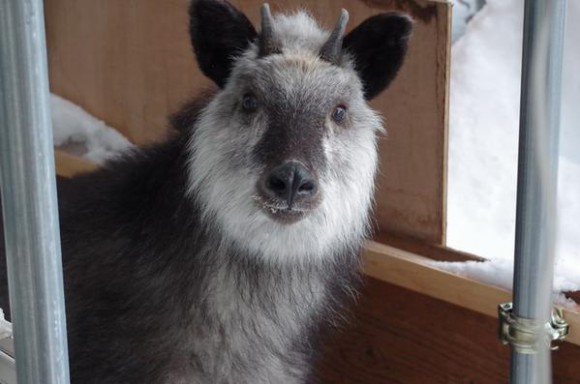
If you head out to the countryside in Japan you’re likely to notice that there’s a whole lot of wildlife to be found on these myriad islands. Whether it’s brown bears (Hokkaido), venomous snakes (Okinawa), or stinging centipedes (Everywhere), it’s important to be aware of what might be lurking. It’s not all creepy crawlies and bitey-stingies, though – there’s a possibility you’ll bump into capering monkeys, wild boar trotting down residential streets, and other adorable and fuzzy members of the animal kingdom. If you’re extra-lucky, one might even seek you out as a special friend, which is what happened to one bloke on Twitter when a deer decided to take up residence under his porch!
Twitter user lodgemotive managed to take several snaps of what looked like a friendly deer who suddenly appeared one snowy winter’s day on his back porch. Seemingly enjoying the attention, the cloven-hooved critter showed no inclination of budging from its comfy spot, prompting lodgemotive-san to turn to his Twitter followers for help on identifying the breed of deer and perhaps gaining some advice on what to do with his new friend.
何か物音がすると思ったらカモシカが来てた。 pic.twitter.com/lN3fKkkfCm
— ロッジモーティブ モリタ(発信専用ミニブログ) (@lodgemotive) January 7, 2015
▲ “Heard a strange noise and came face to face with this deer…”
ずっと居座ってるんだけど、なにコレどうすればいいの? pic.twitter.com/JyPbEQ8t04
— ロッジモーティブ モリタ(発信専用ミニブログ) (@lodgemotive) January 7, 2015
▲ “It’s just sitting there watching me. What does it want? And what should I do about it?”
そんな見つめられても・・・。毛がモフモフだねぇ君。 pic.twitter.com/spwZz4TPFN
— ロッジモーティブ モリタ(発信専用ミニブログ) (@lodgemotive) January 7, 2015
▲ “Why are you staring at me, Mr Fluffy Deer?”
最近夜になるとガサガサ音がしてたのはカモシカだったのか。たぶん屋根下で雪囲いがあって休憩するのに丁度いいスペースなのでしょう。 pic.twitter.com/1VZk3vbRia
— ロッジモーティブ モリタ(発信専用ミニブログ) (@lodgemotive) January 7, 2015
▲ “Now I’m wondering if these clattering noises I’ve been hearing at night were caused by deer? I guess it’s nice and cosy under my porch roof…”
ちなみに胴体と足の位置関係はこちら。カモシカも自分も首を伸ばしてお互いの方向を見てるので、こんな感じに写りました。 pic.twitter.com/a3PqWdlAGt
— ロッジモーティブ モリタ(発信専用ミニブログ) (@lodgemotive) January 8, 2015
▲ “Here’s a few better shots of the front of the deer.”
It didn’t take long for knowledgeable twitizens to make a positive ID on the deer. It turns out to be a Japanese Serow, (Nihon Kamoshika) or wild goat-antelope, which is actually a protected species.
“@lodgemotive: 何か物音がすると思ったらカモシカが来てた。 pic.twitter.com/epU1FYoeQp”
— うちみ@JA60 (@uchiumimasato) January 8, 2015
ニホンカモシカさんや!
▲ “That’s a Japanese Serow!”
ニホンカモシカは天然記念物なのでモフモフできない・・・。
— せいら文子🐈 (@sara235tina) January 8, 2015
でもどつかれてもモフモフしたい!>RT
▲ “Japanese Serow are a protected species, so don’t try to pet it… even though it’s super fluffy!”
One savvy responder even provided practical advice to the perplexed tweeter, sharing a link to a Toyama prefectural government webpage which provides info on the correct way to handle a Japanese Serow:
https://twitter.com/sachifen3x20/status/552997465847115776▲ “Sorry to barge in, but I thought this page might be useful to you!”
The webpage states that the Japanese Serow has held protected species status since 1934, and the number of these fluffy deer-antelope has actually been increasing, meaning that it’s quite common now for people to catch glimpses of them in the hills and surrounding areas. They’ve actually become quite a nuisance in some areas as they have a naughty habit of munching on crops and saplings. Japanese Serow are also reportedly quite fond of chilling out in the early evening and have been known to sit in the same position for hours, a habit which tends to worry those who observe them. They’re also known to habitually visit the same spot, once they’ve found somewhere comfy – which means that lodgemotive-san can probably count on the fact that he’ll be seeing his fluffy friend quite a bit in the months to come.
If you ever find yourself eyeball-to-eyeball with one of these fuzzy fellows in Japan, the Toyama prefectural government recommends taking the following steps:
- Try not to panic or startle the animal. Japanese Serow can be aggressive if threatened, and may use their horns to gore an assailant.
- Do not approach it or attempt to trap it.
- Since these are wild animals, do not try to touch them.
There’s also a pretty extensive “what to do when…” chart that covers everything from “help, it’s fallen in the river” to “help, it’s eating my plants!” It turns out the answer to them all is “if the situation doesn’t resolve itself, call the local authorities,” but we recommend checking Twitter first to see if anyone there has any advice!
Source: Togech.jp
Image: Twitter @lodgemotive

 Watch out for bicycling deer?! Strange traffic sign confuses and inspires Japanese Twitter
Watch out for bicycling deer?! Strange traffic sign confuses and inspires Japanese Twitter New Nara deer adoption program lets you take home your own pet deer, help with overpopulation!
New Nara deer adoption program lets you take home your own pet deer, help with overpopulation! Kitties, doggies, bunnies, and deer – even more stuff balanced on Japan’s pets!
Kitties, doggies, bunnies, and deer – even more stuff balanced on Japan’s pets! Japanese “yakuza deer” continue to harass restaurant owner at Miyajima 【Photos】
Japanese “yakuza deer” continue to harass restaurant owner at Miyajima 【Photos】 Gang of “yakuza deer” regularly takes over Japanese restaurant’s street-side entrance【Photos】
Gang of “yakuza deer” regularly takes over Japanese restaurant’s street-side entrance【Photos】 Private booths are coming to Japan’s Shinkansen bullet trains even sooner than we’d thought【Video】
Private booths are coming to Japan’s Shinkansen bullet trains even sooner than we’d thought【Video】 Rakuten randomly offers 58 New Year’s osechi feasts in Japan, but did we get a star or a dud?
Rakuten randomly offers 58 New Year’s osechi feasts in Japan, but did we get a star or a dud? The oldest tunnel in Japan is believed to be haunted, and strange things happen when we go there
The oldest tunnel in Japan is believed to be haunted, and strange things happen when we go there Daiso unveils new official mascot, Daizo the elephant
Daiso unveils new official mascot, Daizo the elephant Coca-Cola Japan unveils new sakura design bottle for cherry blossom season 2019
Coca-Cola Japan unveils new sakura design bottle for cherry blossom season 2019 Yokohama restaurant serves fried axolotl, along with giant isopod, camel, and crocodile
Yokohama restaurant serves fried axolotl, along with giant isopod, camel, and crocodile Cosplay costume room tour by Japan’s number-one cosplayer Enako is an eye-opener【Video】
Cosplay costume room tour by Japan’s number-one cosplayer Enako is an eye-opener【Video】 Four Shinto shrines to pray for love at in Japan to start the New Year
Four Shinto shrines to pray for love at in Japan to start the New Year Original Totoro plush toys from 80s and 90s re-issued for Studio Ghibli exhibition
Original Totoro plush toys from 80s and 90s re-issued for Studio Ghibli exhibition Dragon Quest Burgers and Slime drinks are coming to McDonald’s Japan【Video】
Dragon Quest Burgers and Slime drinks are coming to McDonald’s Japan【Video】 Starbucks Japan ready to get Year of the Horse started with adorable drinkware and plushies【Pics】
Starbucks Japan ready to get Year of the Horse started with adorable drinkware and plushies【Pics】 Japanese beef bowl chain Sukiya’s 2026 Smile Box lucky bag basically pays for itself
Japanese beef bowl chain Sukiya’s 2026 Smile Box lucky bag basically pays for itself Hayao Miyazaki says Happy New Year to Studio Ghibli fans with new art for Year of the Horse
Hayao Miyazaki says Happy New Year to Studio Ghibli fans with new art for Year of the Horse Cup Noodle tries an authentic Jiro-style ramen, but something’s not quite right
Cup Noodle tries an authentic Jiro-style ramen, but something’s not quite right The best Starbucks Japan Frappuccinos we want to drink again in 2026
The best Starbucks Japan Frappuccinos we want to drink again in 2026 We revisited Sweets Paradise after a decade to see if Japan’s dessert buffet still delivers
We revisited Sweets Paradise after a decade to see if Japan’s dessert buffet still delivers That time Seiji called JASRAC to ask why he didn’t get paid royalties for his song being on TV
That time Seiji called JASRAC to ask why he didn’t get paid royalties for his song being on TV We found possibly the quietest Japanese-style hotel in Tokyo’s bustling Shinjuku district
We found possibly the quietest Japanese-style hotel in Tokyo’s bustling Shinjuku district Pizza Hut Japan’s hot lucky bags are perfect for a New Year’s pizza party
Pizza Hut Japan’s hot lucky bags are perfect for a New Year’s pizza party Japan’s oldest largetooth sawfish in captivity back on display in Mie Prefecture
Japan’s oldest largetooth sawfish in captivity back on display in Mie Prefecture 7-Eleven Japan starts new temporary luggage storage service in over 300 branches
7-Eleven Japan starts new temporary luggage storage service in over 300 branches Disillusionment at Tsukiji’s tourist-target prices led us to a great ramen restaurant in Tokyo
Disillusionment at Tsukiji’s tourist-target prices led us to a great ramen restaurant in Tokyo Starbucks teams up with 166-year-old Kyoto doll maker for Year of the Horse decorations【Photos】
Starbucks teams up with 166-year-old Kyoto doll maker for Year of the Horse decorations【Photos】 Tokyo considering law requiring more trash cans following litter increase in heavily touristed area
Tokyo considering law requiring more trash cans following litter increase in heavily touristed area Tokyo’s Tsukiji sushi neighborhood asks tour groups to stay away for the rest of the month
Tokyo’s Tsukiji sushi neighborhood asks tour groups to stay away for the rest of the month Tokyo event lets you travel back in time, for free, to celebrate 100 years since Showa era start
Tokyo event lets you travel back in time, for free, to celebrate 100 years since Showa era start Japan may add Japanese language proficiency, lifestyle classes to permanent foreign resident requirements
Japan may add Japanese language proficiency, lifestyle classes to permanent foreign resident requirements Sanrio theme park in Japan announces plans to expand into a Sanrio resort
Sanrio theme park in Japan announces plans to expand into a Sanrio resort Stamina-destroying “Paralysis Noodles” are Tokyo’s newest over-the-top ramen innovation
Stamina-destroying “Paralysis Noodles” are Tokyo’s newest over-the-top ramen innovation Survey asks foreign tourists what bothered them in Japan, more than half gave same answer
Survey asks foreign tourists what bothered them in Japan, more than half gave same answer Japan’s human washing machines will go on sale to general public, demos to be held in Tokyo
Japan’s human washing machines will go on sale to general public, demos to be held in Tokyo Japan’s deadliest food claims more victims, but why do people keep eating it for New Year’s?
Japan’s deadliest food claims more victims, but why do people keep eating it for New Year’s? We deeply regret going into this tunnel on our walk in the mountains of Japan
We deeply regret going into this tunnel on our walk in the mountains of Japan Studio Ghibli releases Kodama forest spirits from Princess Mononoke to light up your home
Studio Ghibli releases Kodama forest spirits from Princess Mononoke to light up your home Major Japanese hotel chain says reservations via overseas booking sites may not be valid
Major Japanese hotel chain says reservations via overseas booking sites may not be valid Put sesame oil in your coffee? Japanese maker says it’s the best way to start your day【Taste test】
Put sesame oil in your coffee? Japanese maker says it’s the best way to start your day【Taste test】 No more using real katana for tourism activities, Japan’s National Police Agency says
No more using real katana for tourism activities, Japan’s National Police Agency says Starbucks Japan reveals new sakura drinkware collection, inspired by evening cherry blossoms
Starbucks Japan reveals new sakura drinkware collection, inspired by evening cherry blossoms Updated cherry blossom forecast shows extra-long sakura season for Japan this year
Updated cherry blossom forecast shows extra-long sakura season for Japan this year Nara deer leave park, head to station for food as tourist numbers tumble due to coronavirus
Nara deer leave park, head to station for food as tourist numbers tumble due to coronavirus Nara asks visitors to stop feeding the deer
Nara asks visitors to stop feeding the deer Nara deer have a heartfelt message for tourists in new travel poster
Nara deer have a heartfelt message for tourists in new travel poster Deer in Nara refuse crackers after Golden Week visitors leave them too full to eat【Photos】
Deer in Nara refuse crackers after Golden Week visitors leave them too full to eat【Photos】 Why deer are drawn to train tracks, and how Japan is solving the problem with this simple block
Why deer are drawn to train tracks, and how Japan is solving the problem with this simple block “Four-eyed” goat sighting spooks Miyagi senior
“Four-eyed” goat sighting spooks Miyagi senior Nara deer takes a stand against upcoming Japanese election by eating electoral poster
Nara deer takes a stand against upcoming Japanese election by eating electoral poster Japanese train goes viral for Nara deer decorations
Japanese train goes viral for Nara deer decorations Nara Park’s first baby deer of the year has been born, is totally adorable【Video】
Nara Park’s first baby deer of the year has been born, is totally adorable【Video】 Nara deer dies with four kilos of plastic in its stomach, tourists cautioned to feed animals properly
Nara deer dies with four kilos of plastic in its stomach, tourists cautioned to feed animals properly Nara’s “deer cookie” rice crackers get their first price increase in 28 years
Nara’s “deer cookie” rice crackers get their first price increase in 28 years All the cutest, fluffy bunnies of Twitter are here to bring some cheer to your week
All the cutest, fluffy bunnies of Twitter are here to bring some cheer to your week Why isn’t there more deer poo in Nara Park? This very strange museum has the answer【Photos】
Why isn’t there more deer poo in Nara Park? This very strange museum has the answer【Photos】
Leave a Reply